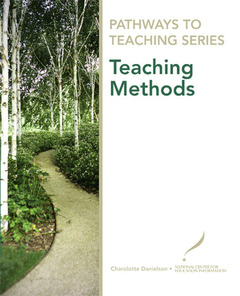Description
Pathways to teaching series
Authors: DANIELSON Charlotte, NATIONAL Center for Education
Language: English
Approximative price 28.23 €
Subject to availability at the publisher.
Add to cart192 p. · 19.1x23.5 cm · Paperback
Description
/li>Contents
/li>
Teaching is extraordinarily important, complex, and demanding work, and a teacher's workday consists of making hundreds of decisions that promote high-level student learning. The work is and should be daunting. Grounded and concise, this first edition text provides readers with theory-based practices that will illuminate the art and craft of teaching.
Through specific examples and sound theories that help teachers build successful classrooms, Teaching Methods presents instruction as a complex profession requiring high-level cogitative work from each teacher. The book successfully synthesizes theories, observations, and research into practical guidelines for instructional planning focused on the emerging needs of the 21st Century.
Part 1 describes the foundations of educational practice: what we know about important learning, and how that learning is assessed, how students learn, and how they are motivated to work hard and engage in high-level learning. The theoretical grounding of high-level teaching, from developmental psychology, cognition, and curriculum and assessment planning, are presented in simple, but not simplistic, language.
Part 2 translates the principles of Part 1 into specific guidelines for instructional planning. It outlines how the big ideas of student learning and cognition may be converted into setting instructional outcomes, developing assessments, and designing learning experiences to promote high-level learning for students.
Part 3 addresses teaching responsibilities beyond the classroom, from grading student performance to communicating with families and participating in a professional community.
Ch1. What we know about content
- The imperative for high-level learning
- Different types of content
Ch2. What we know about assessment
- Different types of assessment
- Matching assessment to learning outcomes
Ch3. What we know about student learning
- Cognitive factors
- Affective factors
- Developmental factors
- Personal and social factors
- Individual differences
Ch4. What we know about motivation
- Extrinsic and intrinsic motivation
- Contributors to intrinsic motivation
Ch5. Knowing our own students
- Home situation
- Cultural environment
- Level of cognitive development
- Skills and knowledge
- Interests and experiences
- Attitudes towards school
Ch6. Establishing learning outcomes
- Terminology
- Level of detail
- Sources of learning outcomes
- Coordination and integration
Ch7. Assessing student learning
- Summative assessments
- Designing scoring guides and rubrics
- Evaluating student work
- Formative assessment
Ch8. Designing learning experiences
- Characteristics
Ch9. A safe and challenging environment
Ch10. Management matters
Ch11. Grading student performance
Ch12. Participating in a professional community
CH13. Moving towards leadership
Appendix: Instructional Examples
Additional Resources
These books may interest you

Teaching Undergraduates 160.25 €



